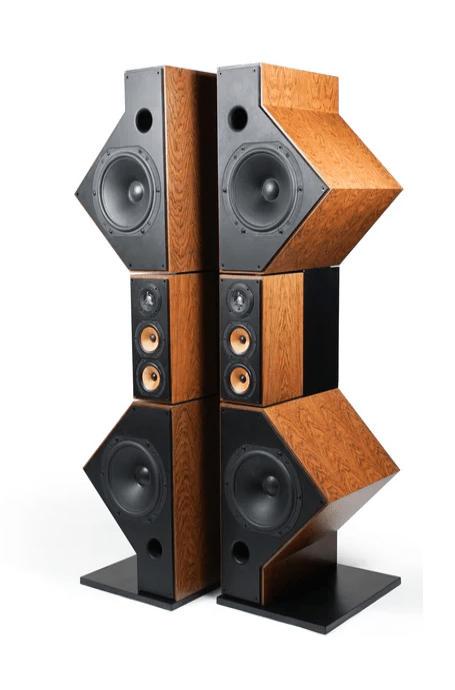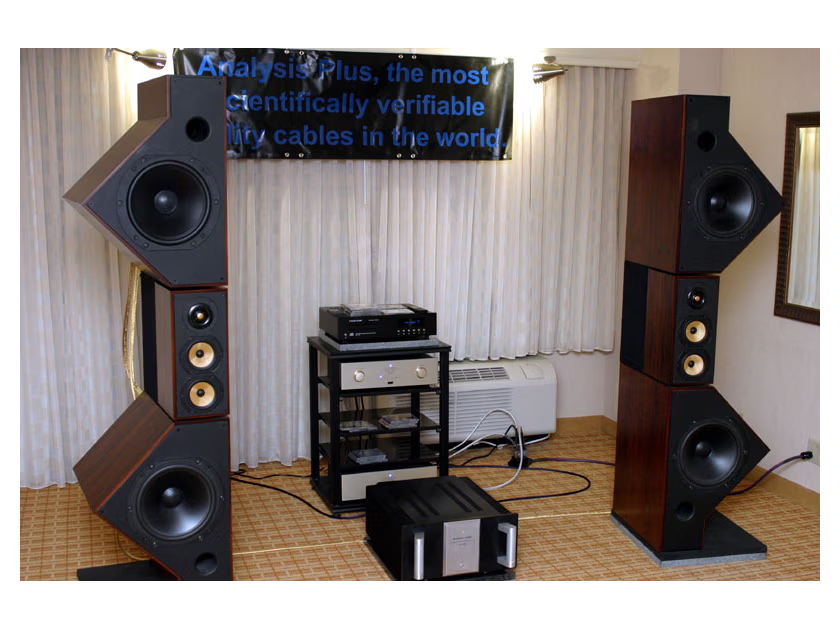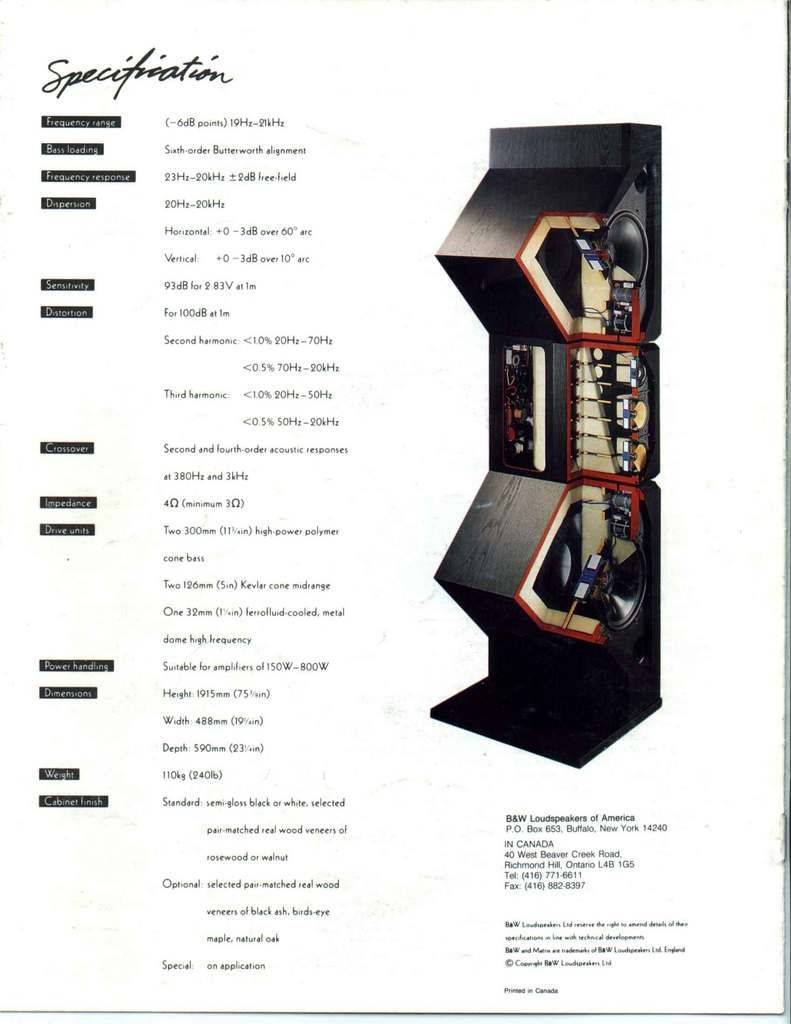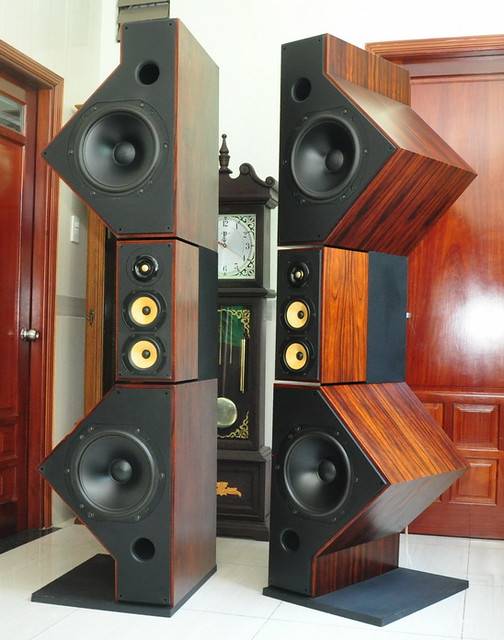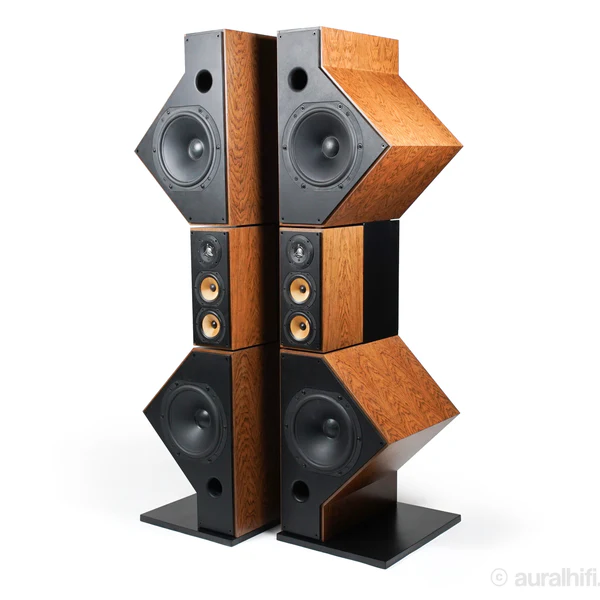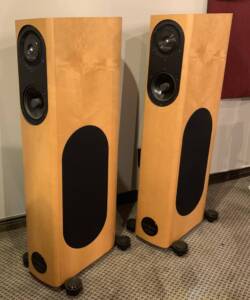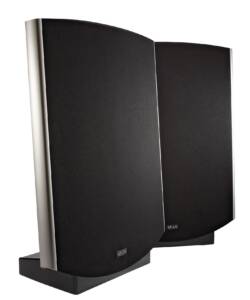B&W Matrix 800 Speakers (Super Rare & Amazing)
Original price was: R250,000.00.R190,000.00Current price is: R190,000.00.
Description:
Three-way, reflex-loaded loudspeaker with line-level bass equalizer.
Drive-units: two 12″ polymer-cone bass, two 5″ Kevlar-cone midrange, one 1.25″ ferrofluid-cooled, metal-dome tweeter.
Frequency response: 23Hz–20kHz, ±2dB free-field.
Impedance: 4 ohms nominal (3 ohms minimum).
Sensitivity: 93dB for 2.83V at 1m.
Recommended power: 150W–800W.
Dimensions: 75.375″ H by 19.25″ W by 23.25″ D. Weight: 240 lbs.
Prices: $18,000/pair (rosewood veneer), $15,000/pair (English walnut, black ash veneers, or painted “satin-black” finish)
Description
B&W Matrix 800 loudspeaker
We all know it’s impossible to reproduce live music. An obvious statement, no doubt, and one that holds every audiophile hostage to the never-ending search. As a musician, I find the situation especially frustrating. The constant reminder of live vs reproduced makes living with an audio system a serious compromise, regardless of price or quality. About three and a half years ago, however, I reviewed a product which I felt, and still feel, offers the first real glimpse of that impossible dream: the B&W 801 Matrix Monitor (footnote 1). Although it wasn’t perfect, I found this speaker provided more musical honesty than anything I had heard before. In this respect, it established a new standard by which others would be judged.Well, B&W has done it again. With the introduction of the Matrix 800, they have redefined the  liaison between music and machine, offering a product that again I feel is destined to become a standard of excellence. This is, in my opinion, the first speaker design to successfully meld the dichotomy of musical and sonic reference, without making any compromises. One may say that this is a contradiction, since “reference” implies an analytical quality rather than the ability to provide an emotionally moving listening experience. And in all other cases, I would have to agree. But not this time. The Matrix 800 has the uncanny ability to uncover the most minute flaws inherent in source material and electronics, while supplying a listening experience only rivaled by live music. Yes, there are more expensive speakers that will provide grander displays of audio spectacle, but not with the same magical mix of musical honesty and ultimate transparency as the 800.
liaison between music and machine, offering a product that again I feel is destined to become a standard of excellence. This is, in my opinion, the first speaker design to successfully meld the dichotomy of musical and sonic reference, without making any compromises. One may say that this is a contradiction, since “reference” implies an analytical quality rather than the ability to provide an emotionally moving listening experience. And in all other cases, I would have to agree. But not this time. The Matrix 800 has the uncanny ability to uncover the most minute flaws inherent in source material and electronics, while supplying a listening experience only rivaled by live music. Yes, there are more expensive speakers that will provide grander displays of audio spectacle, but not with the same magical mix of musical honesty and ultimate transparency as the 800.
With my beloved 801s relinquishing the throne to their new, more expensive cousins, the question must be asked: Do I still like the 801? You bet. Next to the 800, it remains my speaker of choice. The next logical step in this discussion is an apples/apples comparison between the two. A difficult task, since they are so entirely different in all respects. But if I were pushed to make an absolute comparison between these two products, I’d have to say that the 800 is the full realization of the seed planted by the 801. In other words, the 801 redefines dynamic loudspeaker design—the 800 redefines the art of musical reproduction.
Physical highlights
The Matrix 800 is a unique speaker—you’ll either love it or think it’s the ugliest thing since the Edsel. In contemporary surroundings, such as in the company of the art works of Morris Lewis or Pablo Picasso, a pair would be magnificent. But in a small room, decorated with English oak and pine antiques, such as I have, they stick out like the biggest, sorest rosewood thumbs imaginable. When I mentioned to my wife, Lynn-Jane, that perhaps a less obtrusive finish such as black ash would make them more domestically palatable, she came back with “That’s about as effective as rearranging the deck chairs on the Titanic!” We presently have a standoff between speakers and spouse. She hates the way they look but loves the way they sound (a true love-hate relationship). I guess I get to keep them.
Physically, the Matrix 800 stands just over 6′ tall, with quasi-pentagonal woofer enclosures located on top and bottom. Each bass module is the vertical mirror image of the other, with front-venting circular ports located on the very bottom and top of the vertical array. To one side, these woofer cabinets extend into two triangular points, facing sideways, with the opposite side offering a flush surface from top to bottom of the speaker. The midrange/tweeter enclosure is vertically sandwiched between the two woofer modules, and the three cabinets rest on a flat base constructed of heavy-gauge cast alloy filled with nonresonant Fibercrete (the same material used in the midrange/tweeter heads of the Matrix 801 and 802 speakers). There are four threaded metal cones provided, which screw into the bottom side of the base. All three cabinets (two woofer, one midrange/tweeter) are connected with a rear-mounted steel coupling bridge affixed to the central cabinet (which is acoustically decoupled via energy-absorbent mountings).
The two complete speaker assemblies are mirror images of one another, which can either be placed with woofer cabinet points facing inward or outward (toward or away from the opposing speaker). Both of these positions are valid, depending on the individual room acoustics, and will be discussed in greater detail further on in this review.
Although the Matrix 800 differs dramatically in design from any previous B&W product, it represents an application of current technology rather than the incorporation of any radical innovations. According to the people at B&W, the development of the 800 has given them the opportunity to use a significant amount of the data gathered during their ten-year experience with both versions of the 801. Their “Matrix” technology, incorporating an internal system of honeycombs within the cabinets, is employed within the 800’s woofer and midrange/tweeter enclosures and effectively produces sonically inert cabinets.
Unlike the Matrix 801, the 800 has separate crossovers housed in the three separate cabinets. Each woofer enclosure has a low-pass crossover dedicated to the driver inside, and the central cabinet houses the mid/high crossover boards. All crossover components are laid out to minimize any possible interactions and crosstalk, and polypropylene capacitors are used exclusively. There is no internal wiring between high-, mid-, and low-frequency drivers or crossovers. All the connections between the different sections are accomplished externally, via four pairs of WBT gold-plated binding posts (which are the finest I’ve yet come across). All internal wiring between binding posts, crossovers, and drivers is composed exclusively of van den Hul 2.5mm-square silver-plated OFC.
The 800 can be connected to the amplifier in a number of ways, but bi-wiring is suggested as a minimum by the manufacturer. To encourage this, B&W encloses a pair of Monster PowerLine cable jumpers for connecting the two woofers, on top and bottom of each speaker array. There are also pairs of solid metallic jumpers supplied for external connection between tweeter and midrange binding posts, so that all that is basically required is one source cable to the lower woofer binding posts, and one to the midrange or tweeter. Tri- and quad-wiring is also possible (I’ve tried both), as is bi- and tri-amping.
Just as with the 801, the 800 bass units are tuned to a fourth-order Bessel alignment (–6dB at 32Hz). However, the supplied bass-alignment line-level filter (aka “equalizer”) converts the alignment to a Butterworth sixth-order (–6dB at 19Hz). The theoretical benefits conferred by this not only include an extended bass response in a cabinet tuned to a higher fundamental, but also a rapid attenuation (36dB/octave) of any low-frequency information below 19Hz that might cause excessive woofer excursions and possible distortion. While the bass-alignment filter is, in my opinion, a necessity for accurate low-frequency
Before completing the first draft of this review, I bit the bullet, bought a ticket, flew to England, and paid a visit to B&W’s research facility in Steyning, West Sussex. Although the past six months’ auditioning had given me an opportunity to really get to know this product, I wanted to gain some insights into the design, technical background, and raison d’être of the Matrix 800. According to Robert Trunz, the Swiss President of B&W Loudspeakers Ltd., the 800 was the result of his desire to have a higher-sensitivity successor to the 808 monitor loudspeaker, incorporating the 801’s technology. It also had to be capable of producing the very high spls necessary to today’s pop studio requirements, while maintaining a high degree of musical finesse. The man designated for the job of designing this new product was Dr. John Dibb, a member of B&W’s engineering team, who is also responsible for the new Matrix 803, 804, and 805 speakers. Kenneth Grange, of the Pentagram Partnership, was ultimately responsible for the final visual and structural design. During my two days at Steyning, Dr. Dibb supplied me with an impressive amount of information concerning the Matrix 800’s design, as well as taking the time to decipher some of the technical information into a form that this musician could understand.
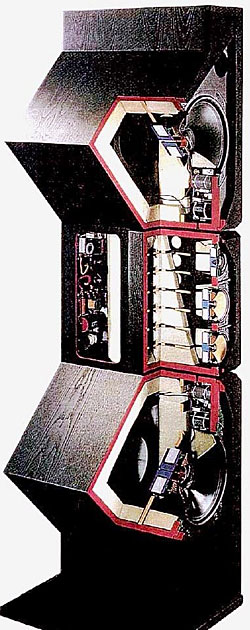 According to Dibb, initial one-box designs using multiple drivers, such as the preceding 808, were abandoned after listening tests proved disappointing. He mentioned that the idea of having bass units at substantially different distances from the room boundaries is not new, and “is based on the theory that the addition of two uneven responses can, with care, produce a more even result.” It is for this reason that “the lower bass unit on the 800 is slightly less than one third the height of the upper, so that cancellation and reinforcement effects from the floor have very few coincident frequencies.” The pentagonal shape of the bass cabinets is dictated by the need to minimize any internal standing waves produced by parallel surfaces; thus the unique shape of the woofer enclosures. While other designs were discussed, the B&W engineers finally opted for the angular shaping of the bass cabinets for reasons of structural strength and ease of manufacturing.
According to Dibb, initial one-box designs using multiple drivers, such as the preceding 808, were abandoned after listening tests proved disappointing. He mentioned that the idea of having bass units at substantially different distances from the room boundaries is not new, and “is based on the theory that the addition of two uneven responses can, with care, produce a more even result.” It is for this reason that “the lower bass unit on the 800 is slightly less than one third the height of the upper, so that cancellation and reinforcement effects from the floor have very few coincident frequencies.” The pentagonal shape of the bass cabinets is dictated by the need to minimize any internal standing waves produced by parallel surfaces; thus the unique shape of the woofer enclosures. While other designs were discussed, the B&W engineers finally opted for the angular shaping of the bass cabinets for reasons of structural strength and ease of manufacturing.
In the upper-frequency domain, Dibb suggested that the best results are “generally obtained when the edge of the baffle is close to the drive-unit, and when the unit dimensions are large in comparison to those of the baffle.” Of course, it would be best to have the tweeter mounted on a very small baffle, such as is the case with the 801. But since the tweeter had to be in close proximity to the midrange drivers, between the two woofers, this was not possible, and the width of the midrange/tweeter cabinet became critical. Calculations apparently dictated that a baffle with the width of 7.5″ (190mm) would be the best compromise, and effectively keep the first reflective high-frequency effects out of the passband of the driver.
Despite several attempts at new midrange driver designs, the existing Kevlar-coned unit used in the 801 was ultimately chosen for the 800. Since output levels required in the 800 system, particularly in the 400Hz–1kHz band, would have pushed one driver to the limit, two identical drivers in parallel were incorporated. Although B&W did try a symmetrical “D’Appolito” topology with a central tweeter flanked by upper- and lower-midrange units, imaging was felt to suffer, and the final configuration with tweeter atop two adjacent midranges was chosen. While both midrange drivers give an equal output at their lowest operating frequency (380Hz), the lower of the two is attenuated at the top of its range, the upper being boosted by the same amount to give a flat response curve. This was done in order to achieve the best polar response, and prevent frequency-dependent imaging and phase problems between tweeter and lower-midrange unit.
The cones of the two 12″ bass drivers are made from the same Cobex material used in the 801’s unit. Soon after the introduction of the 800 speaker, a rubber woofer surround was introduced. Dibb mentioned that their work on the 803, 804, and 805 speakers, subsequent to the initial development of the 800, indicated that the “speed” of the bass attack is dependent on the amount of mechanical damping in the driver (mainly the surround). If the ratio of this to the electromagnetic damping of the driver is reduced, the relative speed of the bass and midrange is improved.
The 1.25″ metal-dome tweeter was apparently conceived as a high-efficiency, high-power unit for professional pop music use. This driver is capable of producing 93dB/W continuous (actually 96dB, but it’s padded down 3dB to maintain lower coil temperatures), with a maximum compression on attack of only 0.5dB. Dibb suggests that this accounts for the excellent transient response of the 800 speaker system. Ferrofluid cooling is incorporated in this new tweeter design, as it is in all of B&W’s new 800 series speakers (including, now, the 801). The large diameter of this new driver means an increased directionality of high frequencies (relative to smaller tweeters), so B&W has incorporated both phase and “loading” rings around the tweeter that minimize high-frequency beaming, giving the unit a more constant directionality over its entire passband. According to the manufacturer, this tweeter is capable of producing 120dB+ dynamic peaks at 4m in a normal listening room.
As the power handling of the 800 is effectively double that of the 801, the APOC (protection circuitry) incorporated in the 801 was deleted from the 800. Dibb felt that past experience with the 801 suggested that APOC is largely superfluous, and that most domestic users will probably never see the protection system operate. He pointed out that the people at B&W were becoming more and more aware of the deleterious sonic effects of various obstacles in the signal path, and that it would not be worth risking any possible audible effects of relays or other such devices for the “sake of one lunatic who might pump enough power in to damage the speakers.” (We all know that no Stereophile reader would think of doing such a thing!)
The 4 ohm input impedance characteristic was chosen for two principal reasons. First, the B&W engineers felt that most good amplifiers (with which this system will, no doubt, be used) would deliver their maximum power into 4 ohms or less. The second refers to the ideal situation where the driving amplifier runs out of volts and current at the same time, thereby delivering the maximum power to the speaker load. This, according to Dibb, is more likely to occur with a 4 ohm load.
Setup
If you’re the type of person who loves to tinker with your car every weekend, and don’t mind having to remove half of the engine in order to change the plugs, you’ll love deciphering the 800 owner’s manual and assembling these monsters. But if you’re like me, this could be a big pain. The 800 comes in six large crates, with no indication of which to unpack first or where anything is supposed to go. The manual is confusing, and often incorrect, which may make you question your ability to read English (“this screw just doesn’t fit into that hole!”). Luckily, in my case, Victor Goldstein (consultant to B&W), Chris Browder (Executive Vice President of B&W Loudspeakers of America), as well as two members of our musicians’ listening group (Al Merz, Ed Kelly) came to the rescue. Victor had set up several pairs of 800s before these, and knew pretty much what to do, while the rest of us looked on in utter disbelief. I recommend that at least two people be available when you assemble your 800s (lifting the midrange/tweeter and upper woofer modules into place requires a combination of brute strength and finesse); better yet, let your dealer do all the work. It took five of us the better part of a day (nine hours) to unpack, assemble, and position my review pair.
Sonic impressions
My first exposure to the Matrix 800 speaker was somewhat of a shock…a very negative shock. It was at the 1990 Stereophile High End Show in New York, where the US debut of this mysterious new super-speaker took place. I had already read a review of the 800 in the German publication Audio, which had proclaimed it to be the best of the best. So, naturally, I was hoping for something that would blow me over. It blew me over, all right, but in the wrong direction. Tubby, overbearing midbass, detached and opaque midrange (or lack of same), and recessed high frequencies greeted my ears. A major disappointment. The two speakers were set up in a large, heavily acoustically damped exhibit room, and they sounded terrible. By the third day of the show, much of the room treatment had been removed, with significant sonic improvement. Much better, but still no cigar.
It wasn’t until I heard the same speaker in Brussels, Belgium, during a National Symphony European tour, that I began to realize that this was a truly great product, and that the New York experience had been an aberration. Since that time, I have auditioned 800s in several venues around the world, and have come to the conclusion that this speaker is ruthlessly revealing of everything upstream, be it electronics or source material (footnote 2).
The 800s work surprisingly well in my small listening room (15′ 4″ W by 16′ 3″ L by 6′ 10″ H), in spite of the low ceiling which allows about 4″ of clearance above the top of the speakers (footnote 3). Although B&W conditionally recommends that the speakers be placed well out from the rear wall, angled in toward the listener (to prevent shifting of the image with head movements), with woofer points outward (away from the opposing speaker), my experience, so far, would suggest that there is no set rule; experimentation is of utmost importance. I have the two speakers set approximately 3½’ from the rear wall (which is lined by cabinets full of LPs and CDs), with woofer points facing inward, placing the central midrange/tweeter cabinets 6½’ apart, on center. Each speaker is about 2½’ from the side wall. The two speakers are angled inward, slightly more open than total convergence at listening position, which is 9½’ from the drivers.
Although several other configurations were tried, this appeared to create the best balance of soundstage dimensionality, along with the fewest room/speaker interface problems. I have found, both in my listening room and at the listening room at B&W’s Steyning research facility, that placing the woofer points outward causes some ringing that may be due to reflections from the midrange drivers along the concave cavity between woofer enclosures from the room side walls. There is a slightly wider soundstage with the points out, but an upper-midrange emphasis in this position makes everything sound a bit forward and hard in my room.
Quad-wiring appears to improve all areas of performance (soundstage dimensionality, transparency, and extended response at both frequency extremes, footnote 4). Quad-wiring is easy: simply run four speaker cables per channel from the amplifier to each of the four pairs of binding posts (two woofers, midrange, and tweeter) of each speaker. Of course, so much high-quality speaker cable can do significant damage to the bank account, but the sonic improvement is well worth the bucks. Tri-wiring (separate cables to midrange and tweeter, and single cable to lower woofer with jumper to top woofer) does not work nearly as well. In this configuration, the upper midrange is too prominent, causing the speaker to sound unnaturally forward. I have not yet tried to bi-amp the 800s. Past experience has shown that identical amplifiers are necessary for correct top-to-bottom balance on any good speaker, and I don’t yet have a pair of identical amplifiers. Furthermore, this speaker will probably be used more often with a single amplifier, so this review will reflect that situation.
Footnote 2: I found out, after the fact, that the New York B&W 800 exhibit used out-of-the-box Jeff Rowland electronics and Straight Wire speaker/interconnect cables, all of which, in my experience, sound absolutely dreadful until after several hours of burn-in. I’ve also discovered that this speaker does not need, or like, highly acoustically damped rooms. Best results are obtained in average listening rooms with little or no sonic treatment.
Footnote 3: In point of fact, however, the room is effectively larger than meets the eye, since an open door between the two speakers into a second, smaller room affords a larger bass-loading area. There is also an open staircase up to the main floor on one side of the listening room, further extending the bass-loading area throughout the entire first floor.
Footnote 4: Bass performance is particularly improved with separate wiring to each woofer. Several people who are technically more knowledgeable than I have suggested that this is probably due to a decrease in the effective output impedance of the amplifier.
reproduction with the 801 Matrix Monitor, I’m not so sure that the situation is the same with the 800. More on this later.
The issue of whether or not to use a bass-alignment filter (either the one supplied with the speakers, or an after-market product) is a gray area, since individual room acoustics, wiring configurations, and your personal listening tastes are involved. Unlike the 801 and 802 speakers, the 800 does not require equalization to obtain excellent bass attack and slam. In fact, when I asked Dr. Dibb about this point, he felt that unless the particular listening space is very bass-shy, addition of an equalizing filter may not be desirable. I found it interesting that the people at B&W in England generally prefer not to use any bass equalization with the Matrix 800, since their experience (and mine) suggest that addition of such a device can cause significant deterioration of midrange clarity despite the filling out of the very bottom octave of bass.
All bass-alignment filters are not the same. The B&W unit supplied with the speakers is not acceptable, adding an obvious sonic haze while dulling mid- and high-frequency attacks. This filter appears to do the least sonic damage when placed in a preamplifier tape loop, rather than between preamp and power amp. Three manufacturers in the aftermarket domain offer high-quality bass-alignment filters. The first contestant, a dual-mono design from Anodyne Acoustics, does considerably better than the stock filter, but has a tendency to soften transients, producing a more than natural midbass bloom. On the plus side, however, this filter appears to extend soundstage depth, which will no doubt appeal to many listeners. This filter is supplied with both single-ended and balanced connectors, and sounds best between preamp and power amp. The second contestant, the MaughanBox 800 MB-II, is built by ListenUp Systems, and comes in a similar configuration to the one from Anodyne. ListenUp, however, has opted to modify the speaker manufacturer’s recommended bass-equalization curve (7dB boost at 20Hz vs the specified 6dB boost at 24Hz), claiming that this will remove some of the bass boom often occurring in many rooms with the 800 at 30–60Hz. I’m not going to argue with their premise, other than to say that in our room, with such an equalization, this filter produces a noticeable midbass leanness and dry (vs reverberant) acoustical perspective. Extreme low bass does benefit, but at the expense of pitch definition in the contra octave. Soundstage width and depth are marginally increased, but height is truncated.
The third product offering comes from Krell Industries. I hesitate to go into great detail with this model, simply because I have a prototype sample which may or may not be identical to production units. I’d have to say, after initial listening, that this equalizer holds the best hope, so far, of not screwing up the midrange and highs.
While on the subject of bass response, it might be interesting to note that the addition of a second woofer actually decreases midbass boom. Upon disconnection of the top woofer, bass response becomes less even and tight, and a significant amount of spatial ambience is lost. One might assume that two woofers would exacerbate any room/bass interface problems, but it appears that placement of the second woofer is indeed critical, as Dibb’s theory suggests. Perhaps it is for this reason that the 800 works so well in my small room. Of all the speakers I’ve had in this same listening area over the past eight years, (Quad electrostatics, KEF 105/2s, MartinLogan Monoliths, Infinity RS-1Bs, B&W Matrix 801s and Matrix 802s), none have provided as much bass clarity as the Matrix 800, even though it barely fits into the space. My only caution concerning room placement with this speaker is that physical size of the room is not as important as placement within the room.
About two weeks after first installing the Matrix 800s I noticed a significant deterioration in clarity. Bass became increasingly indistinct, and the midrange slowly turned to mush. Over the course of a week, these magnificent speakers had gone from the musically sublime to the sonically hideous, making me a total nervous wreck. Was I going deaf, or had my whole system turned to rubbish? Regardless of electronics or program material, the sonic murkiness became increasingly worse, to the point that it was almost unlistenable. Finally, during a severe attack of Audiophilia Nervosa Reviewus Interruptus, I phoned B&W in an attempt to get some help. Although they had not heard of this problem previously, they suggested that I inspect the woofer mounting screws, to make sure that all were securely tightened.
All turned out to be very loose; upon tightening, the problem disappeared, with astonishing Jekyll/Hyde results. Dibb guessed that the loose screws allowed the seal around the woofers to open, thus creating an additional acoustical vent, and changing the Q of the bass cabinets. He further postulated that this prevented the tuned reflex port from properly damping woofer excursions, creating the very poor bass quality and transient response. Apparently the combination of high playback levels and climatic changes during overseas shipping had forced the woofer mounting screws to loosen. Since that time, all subsequent woofer mounting screws have been secured with an adhesive, and further plans for improved stability are in the works. I’ve noticed that, unless the screws on the review pair are tightened monthly, the problem tends to recur.
I have never been a fan of speaker grilles. The 800 grilles, however, are noticeably different, since a radiused convex curve is created at the front edges of the midrange/tweeter enclosure when installed. Dibb maintains that this radius is necessary to optimize diffraction, and he may be correct. But I find that these grilles cause far greater musical obstruction and loss of transparency than is gained by lowering diffraction artifacts. Of course, my opinion is not the only one, and a few other listeners did not support this argument. Andrew Litton, conductor and fellow audiophile (footnote 5), strongly suggested that lateral imaging was superior with grilles installed, and the overall sound was more “coherent,” in spite of a “small” loss of transparency. Lynn-Jane agreed with Litton, describing the speakers with grilles as “fuller”- and “sweeter”-sounding. Other fellow musicians, all colleagues of mine from the National Symphony (Bob Kraft, bass trombone; Al Merz and Kenneth Harbison, percussion; Ed Skidmore, double bass) unanimously preferred the speakers sans grilles, claiming much better transparency, ambience, and upper-midrange clarity. Removal of the woofer grilles also seems to make a big difference in clarity and speed of bass attack. The engineers at B&W thought that the grille fabric itself may add a minute but unwelcome resistance to the front-venting reflex port. There is no doubt that the speakers sound dramatically different in each case, and it all boils down to a matter of personal taste.
But there is no personal taste involved when it comes to totally deadpan sonic honesty. In this respect, the Matrix 800 unquestionably redefines the phrase “with garbage in, you get garbage out.” Not to say that any of the electronics, interconnects, and speaker cables I have at home fall into the garbage category, unless you consider such names as Krell, Mark Levinson, Theta, Esoteric, Straight Wire, AudioQuest, Kimber, et al to be of such quality.
Unfortunately, this very attribute could turn out to be the Achilles’ Heel of the 800. As Ed Skidmore so eloquently noted, “these speakers are analogous to looking at yourself in the Howard Johnson’s mens’ room mirror on the New Jersey Turnpike at three o’clock in the morning. Those awful yellow-green fluorescent lights show you more than you really want to know.” In this sense, the Matrix 800 can best be described as the ideal audio microscope, examining everything it sees, magnifying that image, and delivering the truth, warts and all. Even the slightest system change, such as replacing one pair of interconnects, or a minuscule variation in the AC mains line voltage, has the potential to make or break the sound with these speakers. There are times, late at night, when the sound is absolutely glorious. The next morning, the same setup can sound quite ordinary. Good recordings will sound better than you ever imagined, but give this speaker cold, out-of-the-box electronics or cables, and the results can be unlistenable. This attribute is a double-edged sword, making this speaker the choice only for those listeners willing to invest the time and expense necessary to get the best out of such a high-performance thoroughbred.
Even though the 800 is very efficient, with a 4 ohm impedance and 93dB sensitivity, it loves power. I would recommend a minimum of 200Wpc, and more, if the budget allows. Both the Mark Levinson No.23.5 and Krell KSA-250 are perfect matches for the 800, although it definitely likes the dynamic punch of the latter. Of course, the Krell MDA-300 (with 600W into 4 ohms) is fabulous but it is certainly not necessary for excellent results. I don’t know of any other speaker that will give as much sonic excellence with a single amplifier. In that respect, the 800 is a bargain.
Musical results
From the moment I first heard the Matrix 800s in our home, I knew that there was no way back. It is impossible to adequately describe what these speakers do to the listening experience short of saying that, after this, all others sound lifeless and compressed. “Open,” “spacious,” “transparent,” “dynamically unrestrained,” are only a few of the terms that I can conjure up to attempt a sonic description. Not unlike the first time I played in Carnegie Hall: the sense of immediacy with the musical performance became overwhelming.
“Dance of the Seven Veils,” from Richard Strauss’s Salome (Antal Dorati/RPO, Chesky CD36) was the first piece auditioned after initial setup, and the results were stunning: a huge, wall-to-wall soundstage, high and deep, with dynamic presence approaching the real thing. Every instrumental section of the orchestra was clearly defined in space, almost as if I could jump out of my chair and touch the performers. A totally open sound, without any barriers between listener and musicians. Tight, clean bass transients, without any trace of boominess. But perhaps these super speakers’ most impressive aspect was the way in which they reproduced the ambience surrounding each instrument, defining the material density of each instrumental color in a vibrant sonic image.
In recording after recording, the honesty of these speakers came through, making me sit up and take notice. Everything in the source material was revealed with startling clarity. Unfortunately, this uncovered a multitude of sins, both sonic and musical. Unwanted noises such as chairs squeaking on stage during recording sessions, people talking, doors closing, and even traffic outside were suddenly apparent. Overly miked recordings, tolerable before, became unlistenable. In the musical realm, every aspect of the performance was made more obvious. Sloppy ensemble playing and wrong notes were suddenly unveiled. Key noise and breathing from the brass and woodwinds were, for the first time, apparent. As if a layer of fog was lifted from the musical performance, every individual musical line was now clearly delineated.
The overall sonic impact of the Matrix 800 is a study in perfection. Products such as the Wilson Audio WAMM and the Infinity IRS V will definitely put more sound into a larger space. But I do not believe that any other speaker, regardless of cost or size, offers the same magical mixture of ultimate clarity, dynamic impact, and musical integrity supplied by the 800. On the top end of the dynamic scale, the Matrix 800 is totally effortless, with never a sense of strain or sonic compression. Of course, some of the other heavy hitters in the speaker world will transmit the same volume of sound, but not with the 800s’ speed and control. The leading edge of attack (in other words, what happens immediately before and after a musical transient) is so necessary to the overall sonic impression. A bass tuba transient will move much more air than a bassoon; a double-bass attack will have more sonic weight than a violin. And when a full orchestra is involved, the speaker must be able to reproduce each separate instrumental transient accurately, en masse, or the entire sonic picture will be compressed and dull. This is where the 800’s amazing dynamic speed and ease are apparent. Every instrumental and vocal attack is clear, precise, and transparent, with the proper weight and focus, just as in live performance.
The 800 is equally impressive on the other end of the dynamic scale. Even during the loudest climaxes in vocal and orchestral music, this speaker retrieves the finest dynamic nuances, allowing every musical line to be clearly heard. All of the softest “sub-dynamic” attacks heretofore lost in playback are now clearly reproduced, allowing the listener to hear into, rather than at, the performance. So while this speaker will pin you against the back of your chair with a 100dB+ wavefront, it will simultaneously retain the low-level resolution formerly associated with the finest electrostatic designs. It can speak very softly, but carries a big stick.
If you value accurate soundstaging, this is your ideal speaker. Many others give impressive displays of depth, width, and even height. But nothing, so far, equals the natural sense of ambience and musical reconstruction within the soundstage. I use the term musical, since many similar products rely on frequency aberrations to supply dimensionality. The 800 does not, and in fact does something else that I believe is a first: accurate rendition of size within the soundstage. As an example, the Mercury Living Presence reissue CD of British and American Band Classics (Frederick Fennell/Eastman Wind Ensemble, Mercury 432 009-2) features a group of approximately 44 musicians, seated in tight block formation, in five rows. All in all, a very compact ensemble. With every other speaker, it has always come off sounding like a big wind band, spread out on the stage. But the Matrix 800 portrays it accurately: a small group playing on a very large stage. Conversely, the Vienna Philharmonic spreads from wall to wall, and 50′ behind the speakers in the CBS recording of Gustav Mahler’s Symphony 3 (Lorin Maazel, CBS M2K 42403). The horn section is solidly placed well behind the speakers, and above stage level (the VPO, like most other European orchestras, plays on tiered risers), with the strings appearing far forward, at ground level.
Harmonically, the 800 is dead on. Not only are the harmonic structures of individual instruments and voices amazingly well reproduced, but the pitch of each is also clearly delineated. One might not think that this is important, but pitch clarity allows the listener to pick out individual musical components within complex passages (such as one voice in a choir of a hundred), and hear, for better or worse, each performer’s intonation. This is one of the things that I have always been aware of in live performance, but up until now had not been able to retrieve from recorded source material.
Every musician who has heard these speakers has come away in awe. The harmonic accuracy, overall clarity, and realistic rendition of the musical impact is without peer. Andrew Litton, after hearing a playback of his Tchaikovsky Symphonies 1 and 2 with the Bournemouth Symphony Orchestra (Virgin Classics VC 7 91119-2) proclaimed this to be the first time that he had ever heard a performance as it sounded in the hall, in proper perspective, with all of the impact intact. Interestingly enough, one is not aware of the spectacular bass response, the open and clear midrange, or the smooth high end. Nor does one single out the incredibly lifelike soundstage, extending far beyond the speaker and room boundaries. Why? Because listening to this speaker makes you forget you’re hearing sounds through a mechanical device. When you hear music through the Matrix 800, you’re not hearing hi-fi—you are at the performance. Above all else, this speaker brings the human essence behind the performers to life. And that is what musical reproduction is all about.
Shortcomings
There are none.
Conclusion
The B&W Matrix 800 redefines the art of loudspeaker design. To this end, it goes far beyond anything else currently available, regardless of price or size. While I can’t imagine anyone not being impressed with the sheer dynamic capabilities and enormous soundstage of this speaker, it is far too demanding of time and ancillary electronics for the casual listener. Musically, it has no peers. The B&W 800 is the ultimate musicians’ reference transducer, retrieving every nuance of the recorded performance. In fact, I’m putting my money where my music is, and buying the review pair. So if you want the best, and are searching for that elusive dream of the absolute, there is nothing, short of the real thing, that will bring you closer to live music.
